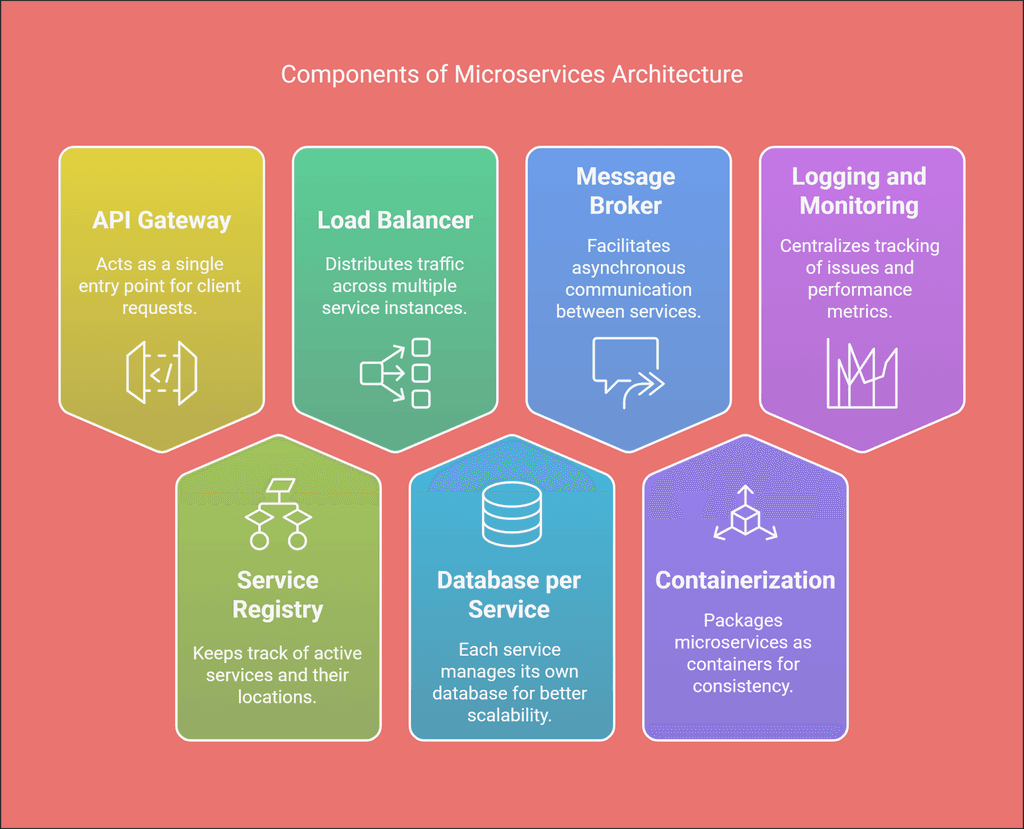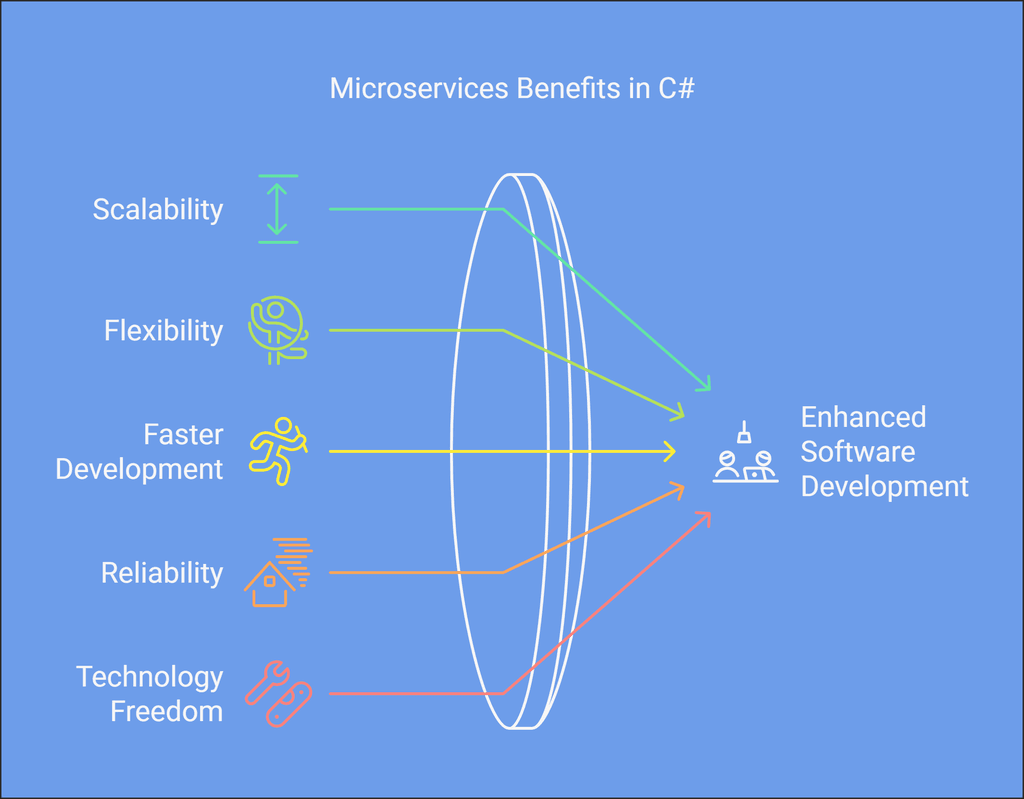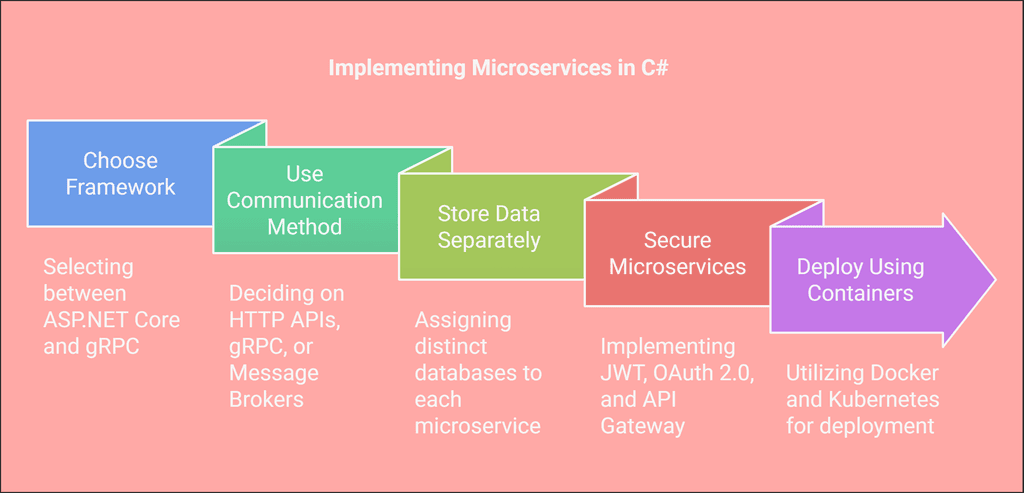Role of Microservices in C#

Introduction
In today’s fast-paced world, software development is evolving rapidly. One of the most popular architectural styles is Microservices. It helps in building scalable and flexible applications. If you are working with C#, you can use microservices to improve your software's performance and maintainability.
Microservices architecture has gained widespread adoption because it allows applications to be developed, deployed, and managed as a collection of small, independent services.
This approach differs from the traditional monolithic architecture, where all components are tightly coupled within a single application. In a microservices-based system, each service is responsible for a specific business function and operates independently, communicating with other services via APIs.
Using microservices in C# enables developers to create highly modular applications where each service can be built, tested, and deployed separately.
This reduces dependencies between different parts of the system, making the application more resilient to failures and easier to scale. Companies such as Netflix, Amazon, and Microsoft have successfully adopted microservices to improve performance, enhance flexibility, and accelerate innovation
What are Microservices?
Microservices is a way of designing software applications as a collection of small, independent services. Each service focuses on a specific task and communicates with others through APIs. Unlike traditional monolithic applications, microservices allow developers to work on different parts of the application independently.
This means that teams can develop, deploy, and update services without waiting for the entire application to be ready. It also helps businesses release features faster, leading to improved customer satisfaction.
What is Microservices Architecture?
Microservices architecture is a software design approach where an application is structured as a collection of loosely coupled, independently deployable services. Each microservice is responsible for a specific functionality and communicates with other services using APIs. This approach offers benefits such as better scalability, improved fault isolation, and faster development cycles.
Unlike monolithic architecture, where all components are interconnected within a single application, microservices allow different teams to develop, deploy, and scale services independently. This modularity makes applications easier to manage, update, and enhance over time.
Key characteristics of microservices architecture include
Independent Deployment: Each microservice can be deployed without affecting other services.
Decentralized Data Management: Each microservice manages its own database.
Technology Agnostic: Different microservices can use different programming languages and databases.
Fault Tolerance: If one microservice fails, it doesn’t bring down the entire application.
Scalability: Services can be scaled independently based on demand.
Components of Microservices Architecture

1. API Gateway
An API Gateway acts as the single entry point for all client requests. Instead of clients interacting directly with multiple microservices, they send requests to the API Gateway, which routes them to the appropriate service. It also provides functionalities like authentication, authorization, request throttling, logging, and caching.
- Example: Ocelot is a widely used API Gateway in .NET Core that helps in routing requests, handling authentication via JWT tokens, and enabling load balancing.
- Use Case: Suppose an e-commerce application has separate microservices for user authentication, product catalog, and order processing. The API Gateway ensures that a single request to fetch user details and order history is internally handled by multiple microservices, returning a consolidated response.
2. Service Registry and Discovery
In microservices, services need a way to dynamically discover each other because they may be running on different hosts or scaling up/down frequently. A Service Registry keeps track of all active services and their network locations. Service Discovery allows services to find and communicate with each other dynamically.
- Example: Consul, Eureka (Spring Cloud Netflix) are commonly used for service discovery.
- Use Case: When a new instance of a microservice (e.g., Payment Service) is launched, it registers itself with the Service Registry. Other microservices (e.g., Order Service) use Service Discovery to dynamically locate the available Payment Service instance.
3. Load Balancer
A Load Balancer distributes incoming traffic across multiple instances of a microservice to ensure high availability and optimal resource utilization. This prevents any single instance from being overwhelmed, improving system stability and performance.
- Example: NGINX, Azure Load Balancer, AWS Elastic Load Balancer
- Use Case: If a Customer Service microservice has 5 instances running, a load balancer ensures that incoming requests are distributed evenly among these instances to prevent overloading any single one.
4. Database per Service
Unlike monolithic applications where a single database is shared, in microservices architecture, each service manages its own database. This prevents data conflicts, improves security, and enhances scalability.
- Example: An Order Service may use SQL Server, while a User Service might use MongoDB to store user profiles in a flexible format.
- Use Case: In an e-commerce system, the Order microservice might use PostgreSQL to store structured transactional data, while the Product Catalog microservice could use Elasticsearch for fast product searching.
5. Message Broker (Asynchronous Communication)
Microservices often communicate asynchronously using message queues. Instead of directly calling another service (which may be slow or unavailable), services publish events/messages, and other services consume them when they are ready.
- Example: RabbitMQ, Apache Kafka, Azure Service Bus
- Use Case: In a food delivery app, when a customer places an order, the Order Service sends a message to a queue. The Payment Service and Delivery Service process the order asynchronously without waiting for a direct response.
6. Containerization and Orchestration
Microservices are often packaged as containers to ensure consistency across different environments. Container orchestration tools help in deploying, scaling, and managing these containers efficiently.
- Example: Docker (for containerization), Kubernetes (for orchestration)
- Use Case: A CI/CD pipeline can use Docker to package each microservice and Kubernetes to manage deployments, automatically scaling instances based on traffic demand.
7. Logging and Monitoring
Since microservices are distributed, tracking issues and performance metrics requires centralized logging and monitoring.
- Example: ELK Stack (Elasticsearch, Logstash, Kibana), Prometheus, Grafana
- Use Case: In a banking system, if a transaction fails, centralized logging helps identify whether the issue was caused by the Payment Service, Notification Service, or API Gateway.
Example of Microservice with ASP.NET Core
This example shows an Order Microservice in ASP.NET Core, where OrdersController fetches order details using IOrderService. The service can interact with other microservices (e.g., Payment or Inventory Service) via API calls or a message broker.
[ApiController]
[Route("api/orders")]
public class OrdersController : ControllerBase
{
private readonly IOrderService _orderService;
public OrdersController(IOrderService orderService)
{
_orderService = orderService;
}
[HttpGet("{id}")]
public async Task<IActionResult> GetOrder(int id)
{
var order = await _orderService.GetOrderByIdAsync(id);
if (order == null)
{
return NotFound();
}
return Ok(order);
}
}Why Use Microservices in C#?
C# is a powerful programming language, widely used for building web applications, desktop software, and cloud-based solutions. When combined with microservices, it offers many benefits:

- Scalability – Each microservice can scale independently, allowing better resource management. If one part of the system experiences heavy traffic, only that microservice can be scaled up without affecting others. This makes it cost-effective and efficient for applications with varying loads.
- Flexibility – Developers can update a specific service without affecting the whole application. This reduces downtime and risk because changes can be made in isolation and tested separately before deployment.
- Faster Development – Teams can work on different services simultaneously, speeding up development. Since different teams handle different microservices, work progresses in parallel, reducing bottlenecks and improving productivity.
- Reliability – If one service fails, it doesn’t bring down the entire system. In monolithic architectures, a failure in one module can crash the entire application, but with microservices, failure is isolated to a single component, improving system stability.
- Technology Freedom – You can mix different technologies in different services as needed. If one service benefits from using C#, another might be better suited for Python or Node.js. This allows developers to use the best tools for each task.
How to Implement Microservices in C#
To build microservices in C#, developers often use .NET Core or ASP.NET Core. These frameworks provide powerful tools for creating fast, reliable, and scalable microservices.

1. Choose the Right Framework
ASP.NET Core – Ideal for building RESTful APIs for microservices. This framework provides a lightweight and high-performance environment for developing web services.
gRPC – Useful for high-performance communication between services. It is an alternative to REST that uses Protocol Buffers to serialize data, making communication faster and more efficient.
2. Use a Communication Method
Microservices communicate using different methods based on use cases:
HTTP APIs – RESTful services using JSON. This is the most common communication method, allowing different microservices to exchange data using HTTP requests.
gRPC – A faster alternative for internal communication. It is highly efficient for large-scale systems where performance is a critical factor.
Message Brokers – Tools like RabbitMQ or Azure Service Bus for asynchronous messaging. These help in decoupling services and ensuring smooth communication, even if some services are temporarily down.
3. Store Data Separately
Each microservice should have its own database to avoid conflicts. This ensures that changes in one microservice’s database do not impact others. Common database choices include:
SQL Server – A robust relational database widely used for enterprise applications.
MongoDB – A NoSQL database that provides flexibility in handling unstructured data.
PostgreSQL – A powerful open-source relational database with advanced features.
4. Secure the Microservices
Security is crucial when designing microservices. Here are some key measures to ensure protection:
JWT (JSON Web Token) for authentication. JWT is a widely used method for securing APIs by issuing encrypted tokens to users.
OAuth 2.0 for authorization. It provides secure access control mechanisms, ensuring only authorized users can access certain services.
API Gateway to manage requests. An API Gateway acts as an entry point for client requests, enforcing security policies and routing requests efficiently.
5. Deploy Using Containers
Microservices can be efficiently deployed using Docker, a containerization platform that packages applications and their dependencies together. Containers ensure consistency across different environments, reducing deployment errors. Additionally, Kubernetes can be used for scaling and managing containers. Kubernetes automates deployment, scaling, and operation of microservices, making it an essential tool for modern applications.
FAQs
Conclusion
Microservices in C# help developers create scalable, flexible, and maintainable applications. By breaking down applications into small, manageable services, businesses can innovate faster and adapt to changing requirements. With ASP.NET Core, gRPC, and other tools, developers can efficiently implement microservices and enjoy benefits like improved scalability, flexibility, and security.
